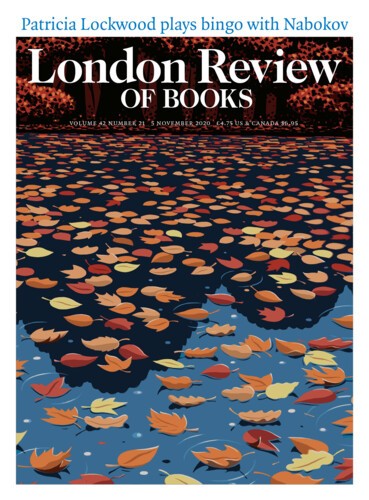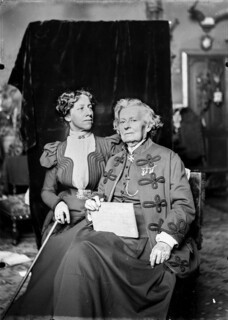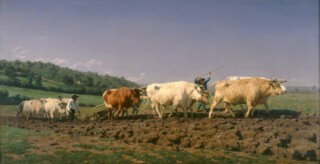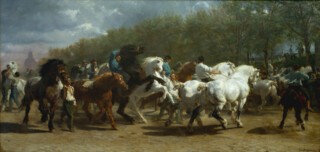The 20th century was not kind to Rosa Bonheur. In her heyday, she was adored by Gilded Age millionaires and the gallery-going public on both sides of the Atlantic. For the Art Journal in 1879, it was irrefutable: ‘Certainly no woman ever lived who has painted so admirably as Rosa Bonheur.’ At the studio sale after her death in 1900, the sums paid for even sketches and preparatory works were unprecedented, raising 1,180,880 francs. Yet within a few decades, prices had begun to plummet, so that by mid-century her work was selling for around a fiftieth of its former value. In France, her achievements were quickly eclipsed by the avant-garde, who cringed at the animalier genre of painting in which she specialised; even in her beloved Fontainebleau, the bronze bull erected to her memory was melted down by the Nazis and never replaced. An important retrospective in Bordeaux, her birthplace, in 1977 began the work of rehabilitation, but there is still some distance to go.
If Bonheur lingers in the popular imagination, it has less to do with her painting than with her eccentricity as a femme artiste: she was a woman who dared to wear trousers and chomp on Havana cigars. Feminist art historians have often found her exasperating. As in the case of Elizabeth Butler, the pre-eminent battle painter of Victorian Britain, Bonheur’s subjects don’t easily lend themselves to gendered analysis. Linda Nochlin deplored Bonheur’s indecision in both asserting and shunning her femininity (Nochlin called it ‘frilly blouse syndrome’). Bonheur exemplifies the problem of the ‘exceptional’ woman painter, whose extraordinary success was interpreted as an anomaly. She styled herself as a Romantic genius like George Sand, to whom she was constantly compared, and seemed to transcend the constraints of her sex.
‘Women’s rights! – women’s nonsense!’ she complained in the 1850s. ‘Women should seek to establish their rights by good and great works, and not by conventions … I have no patience with women who ask permission to think!’ In her final years Bonheur championed younger associates and protégées – such as the Jewish sisters Consuelo and Georges Achille Fould, both of whom painted her portrait – and celebrated the march to gender equality underway in the United States. But she wanted to beat men at their own game, rather than change the rules. Consenting to serve as honorary president of the Société des Femmes Peintres et Sculpteurs, she nonetheless disavowed their separatist agenda: ‘I can’t see such shows without thinking of Mohammed’s paradise, where our Muslim sisters are reduced to having an Eden for themselves.’ Having enjoyed five decades of uninterrupted critical adulation and official gongs, she couldn’t understand why any female artist would settle for a lesser realm. As her latest biographer, Catherine Hewitt, writes: ‘Rosa never called for equality; she ensured that her work earned her that right.’
Where did this sense of exceptional vocation come from? Most historians have stressed the influence exercised by her father, the portraitist Raimond Bonheur. Raimond was employed as an art instructor to Sophie Marquis, the illegitimate daughter of a wealthy Bordelais merchant. Classes turned to courtship and Marie-Rosalie Bonheur was born in 1822. He painted her at four years old, dressed in her Sunday best – white robe and red shoes – mangling a Punch doll in her chubby embrace. In pursuit of commissions, he moved the family to Paris in 1829, where they eked out a parlous existence, frequently changing address (‘In my early years,’ Bonheur recalled, ‘we used to migrate with the birds’). She pined for the farmyard animals she had known in Bordeaux, but found some solace in Sunday walks in the Bois de Boulogne, or outings to the Jardin des Plantes, where Raimond was eventually employed as an illustrator by the naturalist Étienne Geoffroy Saint-Hilaire.
Raimond was a dreamer, and rapidly fell under the influence of various utopian socialist sects. The Saint-Simonians claimed to represent ‘the new Christianity’, combining a passion for industrialism and technocracy with Messianic overtones. He was thrilled by their vision of planetary harmony, and mooned over their leader, Père Enfantin (‘I believe in you as I believe in the sun’). He even devised their tricolour uniforms, including the natty blue frock coat and white waistcoat that could only be fastened at the back (thereby making sartorial co-dependence a sign of brotherly love). In 1832, he decided to temporarily leave the family home and live with his co-disciples in the commune at Ménilmontant, until the group fell foul of the law.
Raimond’s time in the cult had direct consequences for his daughter. Despite the teasing of classmates, she was expected to wear a Saint-Simonian bonnet with oversized tassels – an early lesson in the politics of fashion. Saint-Simonian beliefs about gender complementarity (although rather mystical) and celibacy may have shaped her adult distrust of heterosexual norms. Bonheur was also introduced by her father to the writings of Félicité de Lamennais, nicknamed ‘Robespierre in a surplice’, a radical Catholic democrat who was formally condemned by the Pope. ‘Lamennais defined everything that I searched for,’ she remembered, especially the doctrine that all animals were ensouled. Raimond was also pulled into the orbit of Bernard-Raymond Fabré-Palaprat, who combined his love of dressing up and secret societies by refounding the medieval Knights Templar. Rosa was initiated into the order in a bizarre nocturnal ceremony involving cloaks and candles. While confused about the details, she felt ‘transfigured’ by her crusader experience, which ultimately ‘decided my vocation and my future’.
While Nochlin paints Bonheur as a daddy’s girl, the memoir written by her final companion, Anna Klumpke, describes a more complicated relationship. Rosa Bonheur: Sa vie, son oeuvre is an odd hybrid of first-person testimony coupled with extended sections of ventriloquism, where Bonheur narrates her life in her own words. (The long overdue English translation, by Gretchen van Slyke, was rightly described as an ‘[auto]biography’ when it was published in 1997.) Bonheur was determined to give recognition to her mother: ‘Everything good and beautiful I’ve done during my 76 years on this earth has been her inspiration.’ She was clear-eyed about the way her father’s enthusiasms had contributed to her mother’s domestic suffering and premature burial in a pauper’s grave. ‘My mother, the most noble and proud of creatures, succumbing to exhaustion and wretched poverty, while my father was dreaming about saving the human race.’
Bonheur was 11 when her mother died, but she could already fend for herself. She supported her artistic training by working as a seamstress and making percussion caps for guns. Her father urged her to see things for herself, studying Dutch landscapes in the Louvre as well as drawing directly from nature. She was employed to supervise the artistic education of her brother and sisters too, as the Bonheur studio evolved into a family enterprise with a clear chain of command. One visitor, Paul Delaroche, recalled: ‘There was nothing simpler and more touching than this household with its patriarchal ways.’ And yet, when her father urged her to sign her first works as Raimond, Bonheur refused: the name Rosa, she insisted, was more befitting of her mother’s memory.
She made her debut at the Salon of 1841, with an innocuous painting of rabbits. After that, her progress was astounding. In 1842, her Shorn Ewe, an imposing bronze, earned comparison with the foremost animal sculptor of the period, Antoine-Louis Barye. Bonheur’s competence as a sculptor clearly assisted her modelling of powerful animal bodies in paint. She exhibited six works in the Salon of 1846 and was praised by the socialist critic Théophile Thoré: ‘Mlle Rosa Bonheur’s flock of sheep makes one want to be a shepherd, with a crook, a silk waistcoat and ribbons.’ Her insistence on observing animals in specific, unspoiled regional environments, such as the Auvergne, catered to Parisian audiences’ deepening fascination with the rhythms of rustic life. Thoré was an ardent champion of the northern schools of painting and put Bonheur alongside Dutch 17th-century masters like Paulus Potter (dubbed, apparently without irony, ‘the Raphael of cows’). At the Salon held in the revolutionary conditions of 1848, her composition of Cantal bulls scooped first prize. This success seemed to confirm Thoré’s most daring, and condescending, words of praise: ‘Mlle Rosa paints almost like a man.’
The creation of the Second Republic in 1848 increased the appeal of rural scenes painted in a realist idiom. The Barbizon school had discovered the appeal of nostalgic (and commodified) snapshots of the French countryside as an antidote to France’s urban and industrial ills. In 1849 Bonheur was awarded 3000 francs from the Ministry of the Interior for a grand composition of animals grazing. For its setting she chose the Nivernais, another relatively untouched corner of France, though one recently troubled by insurrection. Her procession of ploughing cattle was realised on a monumental scale, aspiring to a type of history painting without heroes (besides the four-legged ones). Labour was one of the central republican values after 1848, and Bonheur rendered the muscular exertion of the herd, and the churned-up clods of earth, with a palpable naturalism.
She was now richer than her father had ever been; indeed, she used the proceeds from Ploughing in the Nivernais to cover the costs of his funeral. The money also allowed her to set up an independent household with her childhood friend and travelling companion, Nathalie Micas, and Micas’s open-minded mother. With her domestic arrangements settled, Rosa set about trampling ideas of feminine decorum in the pursuit of professional excellence. Determined to understand animal anatomy close-up, she waded into the Abattoirs du Roule and conducted her own dissections; eager to explore the Pyrenees, she applied for formal permission to travel in male attire and was granted an exemption from the arcane law against cross-dressing; for her grandest composition, the 17-foot long Horse Fair, she attended the equine auctions near the Salpêtrière on Wednesdays and Saturdays, always disguised as a man. Unveiled at the Salon of 1853, Horse Fair was hailed as a ‘picture of the century’; it toured widely in Britain and the US, and thanks to Cornelius Vanderbilt, it now hangs in the Metropolitan Museum.
Bonheur was a new kind of celebrity. ‘Life had taught her self-reliance,’ Hewitt writes, ‘and accepting, even flaunting, her own idiosyncrasies had become a survival mechanism.’ It had also become part of her brand. When Édouard Dubufe painted her portrait for the Salon of 1857, she insisted on replacing the ‘boring table’ he had envisaged with a giant bull’s head, painted by herself. The hulking beast upstaged Dubufé’s stilted portrait and pointed to the sitter’s boisterous individualism (‘As far as males go, I only like the bulls that I paint,’ she once said). Bonheur was aware that there was no adequate iconography for female painters, and this emboldened her to craft her own androgynous wardrobe, which she customised depending on the company and occasion. Lucky guests got a glimpse of her in velvet trousers. The blue painter’s smock, sometimes associated with Camille Corot, became a calling card – she once wore it to the Opéra Comique. Newspaper reports savoured her disdain for social niceties, but Bonheur protested that ‘my gruff disposition, which is even a bit uncivilised, has never stopped my heart from staying perfectly feminine.’
Despite her discomfort about discussing money, Bonheur was a shrewd operator, balancing the demands of public and private commissions, and preventing her busy workshop from degenerating into a production line. Her collaboration with the Belgian art dealer Ernest Gambart was central to her career. It was Gambart who snapped up Horse Fair and marketed her in London, acting as a conduit to the lithographers and engravers who would bring her work to thousands. Thomas Landseer, brother of Edwin, made a popular print after Horse Fair, drawing on a smaller replica version produced by Bonheur with under-drawing by Micas (now in the National Gallery).
Gambart also lured Bonheur down to Nice, to stay at his own museum-mansion, Les Palmiers, and sometimes at a nearby house, the Villa Africaine. Here, over several decades, she hobnobbed with an international aristocracy of queens (Alexandrine Saxe-Coburg-Gotha), dukes (Montpensier) and emperors (Pedro II). Although such starry social occasions could be a trial – ‘Such things please me about as much as twenty kicks in the backside!’ – her spells on the Riviera delivered a constant stream of prestigious contacts, not to mention a bounty of amazing beasts: wild mustangs from the American businessman Mark Dunham, panthers loaned by the animal exhibitor Carl Hagenbeck, three polar bears presented by a besotted Grand Duke Mikhailovich (the bears were said to pose on request).
It is hard to exaggerate Bonheur’s fame in the mid-19th century, or the adulation she inspired. Her tour of Britain in 1855, orchestrated by Gambart, was a triumph. A keen reader of Scott, she was especially taken with the Highlands, sketching the lochs and cattle. ‘Rosa was of commanding presence, and looked essentially a being above the common herd,’ the artist Marion Hamilton recalled. ‘Her dress was a compromise between that of a man and a woman; she wore her hair in a brown, curly crop, and she rode on horseback astride, to the horror of all kirk-going folk.’ In London, Bonheur happily received the attentions of Eastlake and Landseer, though the English weather and the snooping English press (‘the Inquisition’) were less to her liking. About Ruskin, a dinner companion, she was withering: ‘He is a gentleman, an educated gentleman; but he is a theorist. He sees nature with a little eye – just like a bird.’ She had already lent her name to a type of variegated red rose; by the 1860s German manufacturers had produced the first Rosa Bonheur porcelain doll. In today’s language, she was an international symbol of empowerment: on beholding Bonheur’s Spanish Muleteers Crossing the Pyrenees (1857) in Gambart’s Pall Mall gallery, George Eliot said ‘What power! This is the way women should assert their rights.’
The second half of Bonheur’s public life brought a further cascade of accolades, from the patronage of Napoleon III’s court to the lavish praise offered at each Exposition Universelle. She negotiated successive regime changes with assurance, further endearing herself to French public opinion in 1870 when she pledged to take up arms against the German invaders in the spirit of Joan of Arc (on their side, Prince Frederick Charles of Prussia issued orders that the redoubtable Bonheur was not to be molested). The press breathed a collective sigh of relief in 1883 when she rapidly recovered from an experimental hysterectomy treatment. Named a chevalier by Empress Eugénie in 1865, who presented the medal in person, Bonheur’s elevation to the rank of officier of the Légion d’Honneur by President Sadi Carnot in 1894 – the only woman so honoured – confirmed what was already inescapable: that Bonheur was a French national monument, as distinctive and unassailable as a Percheron horse or a Charolais cow.
Uneasy with fame and its distractions, Bonheur meanwhile laboured to construct a closed, emotional refuge with her female dependants and animal sidekicks. Her menagerie grew in proportion to her artistic independence. Successive studios and apartments in Paris were full of rabbits, ducks, squirrels, butterflies, goats and sheep (who grazed on the plaine Monceau); there was also Margot the mare and a mischievous, bed-invading otter. By the late 1850s, she and Micas had moved to the chateau of By in Fontainebleau forest, which she christened, optimistically, ‘the domain of Perfect Affection’. Here, her animal family swelled to unheard-of proportions: Ratata the monkey; Roland the horse; Jacques the deer; Gamine the short-haired pooch; the Danish dog Ulm (she liked names with military overtones). This was before the bears and big cats arrived. The domain at By, Hewitt writes, was a ‘zoological kaleidoscope’.
Bonheur’s relations with these animals were indisputably the most tender and intense of her life. Not just models, they were collaborators: ‘I owe them half of what people are pleased to admire in my pictures.’ Néro the lion, rescued from Marseille’s zoological gardens in 1880, used to thrill to her touch, and still came when she called his name years later, blind and abandoned at the Jardin des Plantes; a lioness named Fathma, unable to climb the stairs up to the studio one last time, expired exhausted in Bonheur’s arms. These almost operatic episodes of pathos existed alongside a steely pragmatism. Bonheur saw no tension between nursing injured creatures and pelting others with shot, venturing out into the forests as the self-styled ‘Diana of Fontainebleau’. She could not bear her pets to be sick and insisted on killing any that were frail or in pain, even taking photographs to commemorate the grim deed. When the quails were messy, they were kicked out. When her dogs were judged ‘no good’, they were ditched. Nor could she tolerate the idea of her ‘friends’ falling into enemy hands in wartime. ‘Before winter comes, the animals that ministered to my pleasures and professional wants will have to hop off’: better that, she reasoned in 1870, than have them betray her (and France).
One clue to the status of her animals as surrogate partners and extensions of herself lies in the odd animal aliases she sometimes adopted in her correspondence, signing off as ‘your old donkey of a sister’, comparing herself to a ‘dog that has been playing a flute’, or brooding on her porcine solitude (‘I possess the nature of old boars’). Hewitt reproduces the astonishing 1886 photograph of Rosa lounging on the ground with Fathma the lioness, her gaze confrontational, ‘as though daring the onlooker to challenge her conduct’. Bonheur’s animal antics muddied the distinction between conservation and exploitation: one minute she was communing with her beasts, the next seizing on them as outlandish props for her domestic theatre.
These power dynamics echoed those in her intimate life, which was choreographed in subservience to her art. Bonheur told one journalist in the 1850s: ‘I am not fit to be a wife in the common acceptance of that term. Men must marry women who have no absorbent, no idol.’ Painting was the idol, the ‘tyrant’ of Hewitt’s title, and it demanded total devotion: the perfectionist artist cursed her weaker offerings as ‘infirmities’. Micas accepted her assigned place within the household, making the dinners, preparing canvases and tending the animals, only occasionally erupting in jealousy when other women, like the singer Caroline Carvalho, caught Bonheur’s eye. When Micas died in 1889, Bonheur told Paul Chardin: ‘I live on the souvenirs that surround me, just as if she were here, and I find it difficult to quit them.’
Later that year, however, she met a young, independent-minded American artist who was willing not just to indulge but also to inhabit these memories. Anna Klumpke, aged 32 (Bonheur was 67), was a model lady companion: an attentive art student, musically gifted and willing to record injunctions and reminiscences. She was even willing to physically assume the place left vacant by Micas, moving into her yellow bedroom and accepting her watch, rings and tokens of her hair. Klumpke once described herself as Bonheur’s ‘adopted daughter’ and Bonheur referred to Klumpke as her ‘wife’, though in truth she envisioned theirs as a loftier arrangement: ‘the divine union of two souls’. In her will, Bonheur left Klumpke nearly everything, much to the chagrin of family and friends. She insisted that she be buried next to Micas in Père Lachaise, but Klumpke’s ashes were scattered in the crypt in 1942.
Hewitt documents Bonheur’s self-deprecatory humour and many acts of kindness, though she can’t conceal the authoritarian streak or the mercurial mood of self-contradiction. ‘Rosa Bonheur the artist had become a convenient screen behind which Rosa Bonheur the woman could hide – and frequently did.’ The domestic menagerie was only one kind of disguise: when Millais and Frith came to pay homage to her at Fontainebleau in 1878, she greeted them dressed as an abbé. Her biography will hopefully spur more visits to the By estate, where Bonheur’s studio has recently been saved from closure.
What we need now, though, are new ways of talking about Bonheur’s work, which has been sidelined by her appeal as a Dorothy Doolittle and queer icon. Her paintings languish in the reserves of major museums, while in Paris her name mostly evokes the euphoric gay club in Buttes-Chaumont park. Bonheur’s vast body of work is surprisingly various, both in medium and subject (some of her landscapes without animals are exceptional). Being so commercially successful, she was able primarily to paint for her own satisfaction. As she told her brother Isidore in 1872: ‘I, too, dream of glory!’ She experimented in her final years with photography and pastel. Her undimmed curiosity is evident in the quasi-ethnographic images of Native Americans and bison that were inspired by Buffalo Bill’s show at the 1889 Exposition Universelle.
When describing her methods, Bonheur insisted that each animal had ‘its own individual physiognomy. Before beginning a study of a dog, a horse or a ewe, I familiarised myself with the anatomy, osteology and mythology of each.’ This last term seems crucial, and points to the blend of empiricism and empathy found in her best animal portraits. From the 1870s, Bonheur embraced the allegorical and symbolic potential of her subjects, as seen in prides of lions, set in shimmering abstract landscapes (for example Royale à la maison, from 1885). In her final years she dreamed of American prairies and African plains, where many of her captive ‘friends’ originated, but recognised that she lived in a shrinking world. Her remarkably unsentimental paintings show how attentively she looked at animals and wrestled with their inalienable, non-human qualities. The results can feel dignified, unsettling or elegiac, their intensity symptomatic of a deeper rupture. By this period, as John Berger observed, the ‘images are of animals receding into a wildness that existed only in the imagination’.
Send Letters To:
The Editor
London Review of Books,
28 Little Russell Street
London, WC1A 2HN
letters@lrb.co.uk
Please include name, address, and a telephone number.




